Intel Z68 Chipset & Smart Response Technology (SSD Caching) Review
by Anand Lal Shimpi on May 11, 2011 2:34 AM EST
Intel's SSD 311 20GB: Designed to Cache
Although SRT supports any SSD, Intel created a brand new drive specifically for use as a cache with Z68 platforms. This is the Intel SSD 311, codenamed Larson Creek:
The SSD 311 uses the same controller as Intel's X25-M G2, SSD 310 and SSD 320 drives:
The big difference here is the SSD 311 comes with 20GB of 34nm SLC NAND. If you remember back to the SSD Anthology, SLC NAND is architecturally identical to MLC NAND. With half the number of data stored per NAND cell SLC NAND not only lasts longer than MLC NAND but it also is much faster, particularly for writes.
As a cache that'll be constantly written to, SLC NAND isn't a bad decision on Intel's part. Intel insists that the move wasn't motivated by reliability but rather write performance.
A quick look at the performance of the SSD 311 shows that it packs a lot of punch for being a small 20GB drive with only 5 of 10 NAND channels populated:
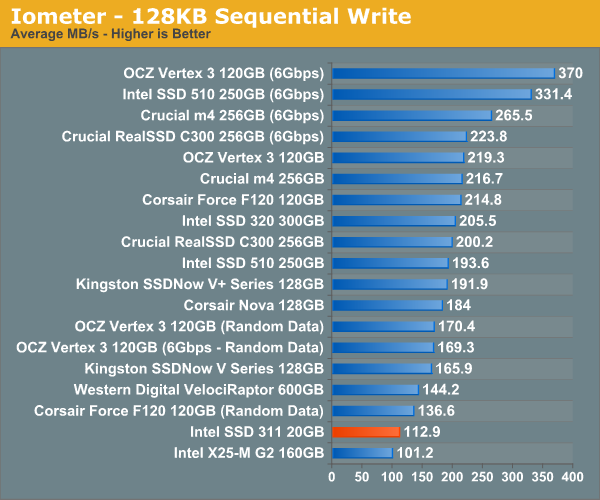
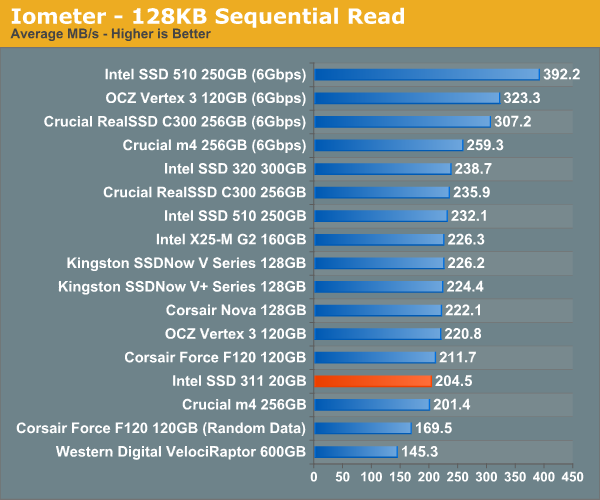
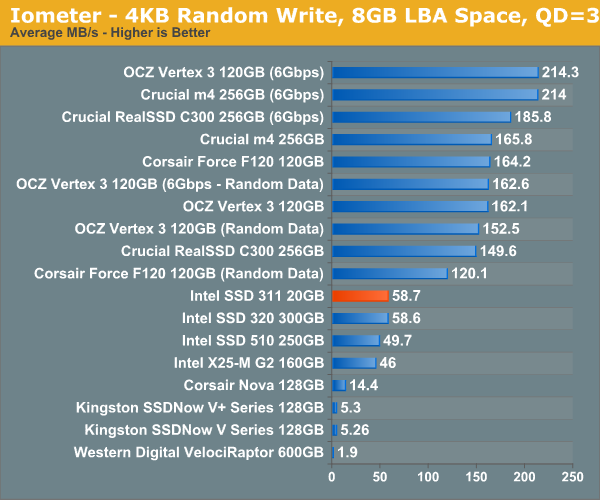
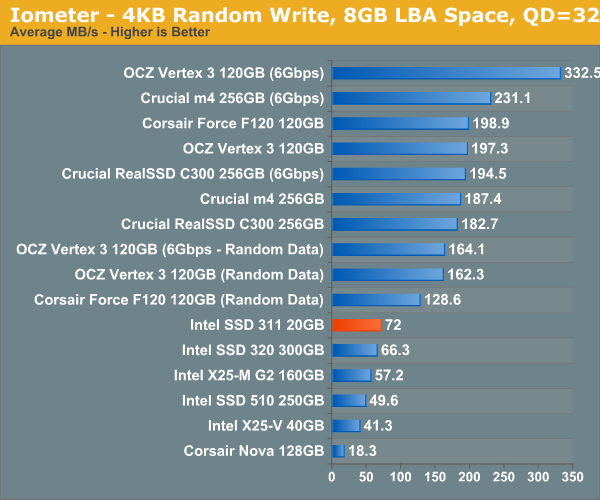
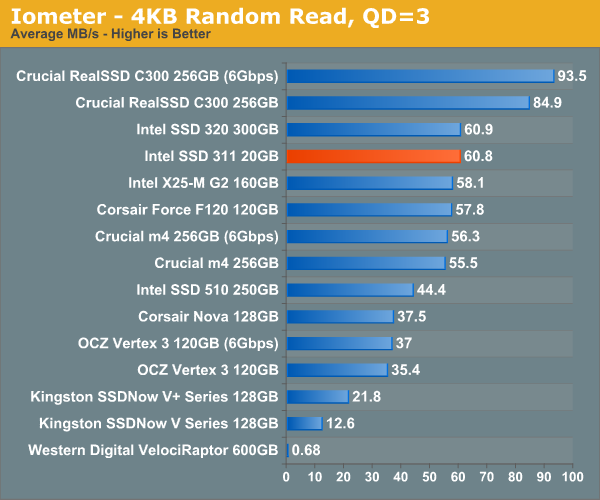
The SSD 311 basically offers the performance of a 160GB X25-M G2 but with fewer NAND channels and a much lower capacity.
Remember this is SLC NAND so despite only being a 20GB drive, it's priced more like a 40GB MLC drive: Intel expects the SSD 311 to retail for $110. Thankfully you aren't locked in to only using Intel drives as Smart Response Technology will work with any SSD.




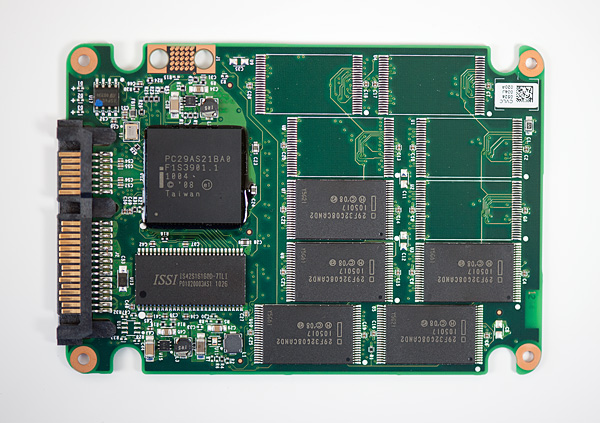
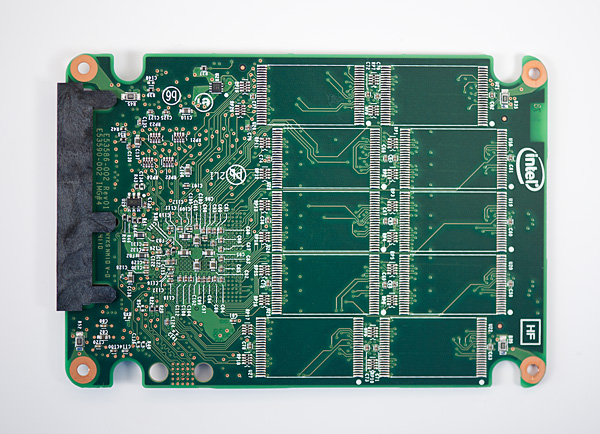








106 Comments
View All Comments
cbass64 - Wednesday, May 11, 2011 - link
RAID0 can't even compare. With PCMark Vantage a RAID0 with MD's gives you roughly a 10% increase in performance in the HDD suite. A high end SSD is is 300-400% faster in the Vantage HDD suite scores. Even if you only achieve 50% of the SSD performance increase with SRT you'd still be seeing 150-200% increase and this article seems to claim that SRT is much closer to a pure SSD than 50%.Obviously benchmarks like Vantage HDD suite don't always reflect real world performance but I think there's still an obvious difference between 10% and a couple hundred %...
Hrel - Thursday, May 12, 2011 - link
all I know is since I switched to RAID 0 my games load in 2/3 the time they used to. 10% is crazy. RAID 0 should get you a 50% performance improvement across the board; you did something wrong.DanNeely - Thursday, May 12, 2011 - link
Raid only helps with sequential transfers. If Vantage has a lot of random IO with small files it won't do any good.don_k - Wednesday, May 11, 2011 - link
Or the fact that it is an entirely software based solution. Intel's software does not, as far as I and google know, run on linux, nor would I be inclined to install such software on linux even if it were. So this is a non-starter for me. For steam and games I say get a 60-120gb consumer level ssd and call it a day. No software glitches, no stuff like that.This kind of caching needs to be implemented at the filesystem level if you ask me, which is what I hope some linux filesystems will bring 'soon'. On windows the outlook is bleak.
jzodda - Wednesday, May 11, 2011 - link
Are there any plans in the future of this technology being made available to P67 boards?Before I read this I thought it was a chipset feature. I had no idea this was being implemented in software at a driver level.
I am hoping that after a reasonable amount of time passes they make this available for P67 users. I understand that for now they want to add some value to this new launch but after some time passes why not?
michael2k - Wednesday, May 11, 2011 - link
Given that the drive has built in 4gb of flash, it would be very interesting to compare this to the aforementioned SRT. Architecturally similar, though it requires two drives instead of one. Heck, what would happen if you used SRT with a Seagate Momentus?kenthaman - Wednesday, May 11, 2011 - link
1. You mention that:"Even gamers may find use in SSD caching as they could dedicate a portion of their SSD to acting as a cache for a dedicated games HDD, thereby speeding up launch and level load times for the games that reside on that drive."
Does Intel make any mention of possible future software versions allowing user customization to specifically select applications to take precedence over others to remain in cache. For example say that you regularly run 10 - 12 applications (assuming that this work load is sufficient to begin the eviction process), rather than having the algorithm just select the least utilized files have it so that you can point to an exe and then it could track the associated files to keep them in cache above the priority of the standard cleaning algorithm.
2. Would it even make sense to use this in a system that has a 40/64/80 gig OS SSD and then link this to a HDD/array or would the system SSD already be handling the caching? Just trying to see if this would help offload some of the work/storage to the larger HDDs since space is already limited on these smaller.
Midwayman - Wednesday, May 11, 2011 - link
What is the long term use degradation like? I know without TRIM SSD's tend to lose performance over time. Is there something like trim happening here since this all seems to be below the OS level?jiffylube1024 - Wednesday, May 11, 2011 - link
Great review, as always on Anandtech!This technology looks to be a boon for so many users. Whereas technophiles who live on the bleeding edge (like me) probably won't settle for anything less than an SSD for their main boot drive, this SSD cache + HDD combo looks to be an amazing alternative for the vast majority of users out there.
There's several reasons why I really like this technology:
1. Many users are not smart and savvy at organizing their files, so a 500GB+ C drive is necessary. That is not feasible with today's SSD prices.
2. This allows gamers to have a large HDD as their boot drive and an SSD to speed up game loads. A 64GB SSD would be fantastic for this as the cache!
3. This makes the ultimate drop-in upgrade. You can build a PC now with an HDD and pop in an SSD later for a wicked speed bump!
I'm strongly considering swapping my P67 for a Z68 at some point, moving my 160GB SSD to my laptop (where I don't need tons of space but the boot speed is appreciated), and using a 30-60GB SSD as a cache on my desktop for a Seagate 7200.12 500GB, my favourite cheap boot HDD.
samsp99 - Wednesday, May 11, 2011 - link
Is the intel 311 the best choice for the $$, or would other SSDs of a similar cost perform better. For example the egg has OCZ Vertex 2 and other sandforce based drives in the 60GB range for approx $130. That is a better cache size than the 20GB of the intel drive.Sandforce relies on compression to get some of its high data rates, would that still work well in this kind of a cache scenario?